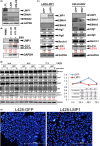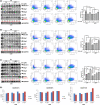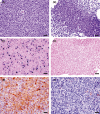Epstein-Barr virus latent membrane protein-1 upregulates autophagy and promotes viability in Hodgkin lymphoma: Implications for targeted therapy
- PMID: 33525055
- PMCID: PMC8019199
- DOI: 10.1111/cas.14833
Epstein-Barr virus latent membrane protein-1 upregulates autophagy and promotes viability in Hodgkin lymphoma: Implications for targeted therapy
Abstract
Hodgkin lymphoma (HL) is composed of neoplastic Hodgkin and Reed-Sternberg cells in an inflammatory background. The neoplastic cells are derived from germinal center B cells that, in most cases, are infected by Epstein-Barr virus (EBV), which may play a role in tumorigenesis. Given that EBV-latent membrane protein 1 (LMP1) regulates autophagy in B cells, we explored the role of autophagy mediated by EBV or LMP1 in HL. We found that EBV-LMP1 transfection in HL cells induced a modest increase in autophagy signals, attenuated starvation-induced autophagic stress, and alleviated autophagy inhibition- or doxorubicin-induced cell death. LMP1 knockdown leads to decreased autophagy LC3 signals. A xenograft mouse model further showed that EBV infection significantly increased expression of the autophagy marker LC3 in HL cells. Clinically, LC3 was expressed in 15% (19/127) of HL samples, but was absent in all cases of nodular lymphocyte-predominant and lymphocyte-rich classic HL cases. Although expression of LC3 was not correlated with EBV status or clinical outcome, autophagic blockade effectively eradicated LMP1-positive HL xenografts with better efficacy than LMP1-negative HL xenografts. Collectively, these results suggest that EBV-LMP1 enhances autophagy and promotes the viability of HL cells. Autophagic inhibition may be a potential therapeutic strategy for treating patients with HL, especially EBV-positive cases.
Keywords: Epstein-Barr virus; Hodgkin lymphoma; autophagy; chloroquine; latent membrane protein-1; xenograft.
© 2021 The Authors. Cancer Science published by John Wiley & Sons Australia, Ltd on behalf of Japanese Cancer Association.
Conflict of interest statement
The authors declare no conflicts of interest.
Figures






Similar articles
-
Epstein-Barr virus latent membrane protein-1 up-regulates cytokines and correlates with older age and poorer prognosis in Hodgkin lymphoma.Histopathology. 2017 Feb;70(3):442-455. doi: 10.1111/his.13085. Epub 2016 Nov 8. Histopathology. 2017. PMID: 27632954
-
Hodgkin lymphoma: a review of pathological features and recent advances in pathogenesis.Pathology. 2020 Jan;52(1):154-165. doi: 10.1016/j.pathol.2019.09.005. Epub 2019 Nov 5. Pathology. 2020. PMID: 31699300 Review.
-
Follicular dendritic cells display microvesicle-associated LMP1 in reactive germinal centers of EBV+ classic Hodgkin lymphoma.Virchows Arch. 2019 Aug;475(2):175-180. doi: 10.1007/s00428-019-02605-w. Epub 2019 Jun 15. Virchows Arch. 2019. PMID: 31203443 Free PMC article.
-
Prognostic significance of Epstein-Barr virus (EBV) infection in Hodgkin lymphoma patients.J Infect Chemother. 2017 Mar;23(3):121-130. doi: 10.1016/j.jiac.2016.09.004. Epub 2016 Dec 26. J Infect Chemother. 2017. PMID: 28034523
-
[Molecular biological properties of the Epstein-Barr virus LMP1 gene: structure, function and polymorphism].Vopr Virusol. 2015;60(3):5-13. Vopr Virusol. 2015. PMID: 26281300 Review. Russian.
Cited by
-
Exploring the interplay between EBV and autophagy-related gene expression patterns in nasopharyngeal carcinoma.Front Oncol. 2025 Jun 24;15:1588921. doi: 10.3389/fonc.2025.1588921. eCollection 2025. Front Oncol. 2025. PMID: 40630202 Free PMC article.
-
Mycobacterial antigen Ag85B restrains Hodgkin lymphoma tumor growth by inhibiting autophagy.Oncol Res. 2025 Apr 18;33(5):1173-1187. doi: 10.32604/or.2025.057842. eCollection 2025. Oncol Res. 2025. PMID: 40296899 Free PMC article.
-
Crosstalk Between Autophagy and Oxidative Stress in Hematological Malignancies: Mechanisms, Implications, and Therapeutic Potential.Antioxidants (Basel). 2025 Feb 25;14(3):264. doi: 10.3390/antiox14030264. Antioxidants (Basel). 2025. PMID: 40227235 Free PMC article. Review.
-
High percentages of peripheral blood T-cell activation in childhood Hodgkin's lymphoma are associated with inferior outcome.Front Med (Lausanne). 2022 Aug 10;9:955373. doi: 10.3389/fmed.2022.955373. eCollection 2022. Front Med (Lausanne). 2022. PMID: 36035394 Free PMC article.
-
Chemotherapy's effects on autophagy in the treatment of Hodgkin's lymphoma: a scoping review.Discov Oncol. 2024 Jul 8;15(1):269. doi: 10.1007/s12672-024-01142-6. Discov Oncol. 2024. PMID: 38976168 Free PMC article.
References
-
- Diehl V, Thomas RK, Re D. Part II: Hodgkin's lymphoma–diagnosis and treatment. Lancet Oncol. 2004;5(1):19‐26. - PubMed
-
- Kuppers R. The biology of Hodgkin's lymphoma. Nat Rev Cancer. 2009;9(1):15‐27. - PubMed
-
- Ushmorov A, Leithauser F, Sakk O, et al. Epigenetic processes play a major role in B‐cell‐specific gene silencing in classical Hodgkin lymphoma. Blood. 2006;107(6):2493‐2500. - PubMed
-
- Piris MA, Medeiros LJ, Chang KC. Hodgkin lymphoma: a review of pathological features and recent advances in pathogenesis. Pathology. 2020;52(1):154‐165. - PubMed
-
- Schroder M, Kaufman RJ. The mammalian unfolded protein response. Annu Rev Biochem. 2005;74:739‐789. - PubMed
MeSH terms
Substances
Grants and funding
LinkOut - more resources
Full Text Sources
Other Literature Sources
Medical
Research Materials

